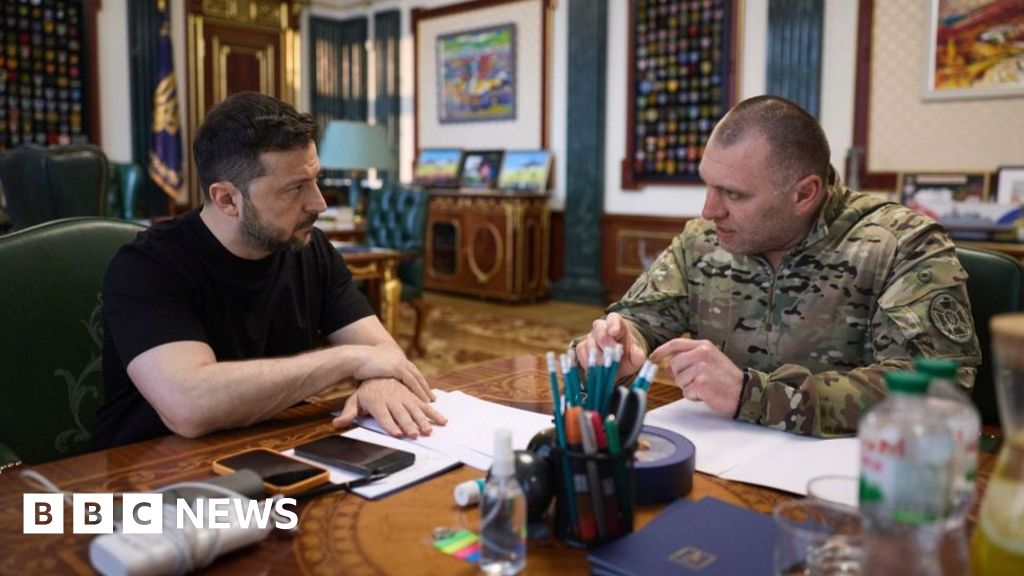BBC News
 Ukraine Presidential Press Service/EPA-EFE/Shutterstock
Ukraine Presidential Press Service/EPA-EFE/ShutterstockIt was an attack of astonishing ingenuity – unprecedented, broad, and 18 months in the making.
On 1 June more than 100 Ukrainian drones struck air bases deep inside Russia, targeting nuclear-capable long-range bombers.
The scale of the operation dubbed “Spider Web” became clear almost as soon as it began, with explosions reported across several time zones all over Russia – as far north as Murmansk above the Arctic Circle, and as far east as the Amur region, over 8,000km from Ukraine.
The Russian Defence Ministry confirmed the attacks had occurred in five regions of Russia – Murmansk, Irkutsk, Ivanovo, Ryazan and Amur – but stated planes had been damaged only in Murmansk and Irkutsk, while in other locations the attacks had been repelled.
In photos released shortly after the attack, Vasyl Maliuk, the head of the Security Service of Ukraine (SBU), can be seen looking at a satellite map of airfields in which the bases in the locations listed by Russia are clearly identifiable.

The operation
Maliuk said the drones were smuggled into Russia inside wooden cabins mounted on the back of lorries and concealed below remotely operated detachable roofs.
The lorries were then apparently driven to locations near airbases by drivers who were seemingly unaware of their cargo; then, the drones were launched and set upon their targets.
Videos circulating online show drones emerging from the roof of one of the vehicles involved. One lorry driver interviewed by Russian state outlet Ria Novosti said he and other drivers tried to knock down drones flying out of a lorry with rocks.
“They were in the back of the truck and we threw stones to keep them from flying up, to keep them pinned down,” he said.
According to unverified reports by Russian Telegram channel Baza – which is known for its links to the security services – the drivers of the lorries from which the drones took off all told similar stories of being booked by businessmen to deliver wooden cabins in various locations around Russia.

Some of them said they then received further instructions over the phone on where to park the lorries; when they did so, they were stunned to see drones fly out of them.
In a triumphant post shared on social media on Sunday night, Ukrainian President Volodymyr Zelensky – who directly supervised the operation – said 117 drones had been used in the daring attack that took “one year, six months and nine days” to prepare.
He also said one of the targeted locations was right next to one of the offices of the FSB Russian security services.
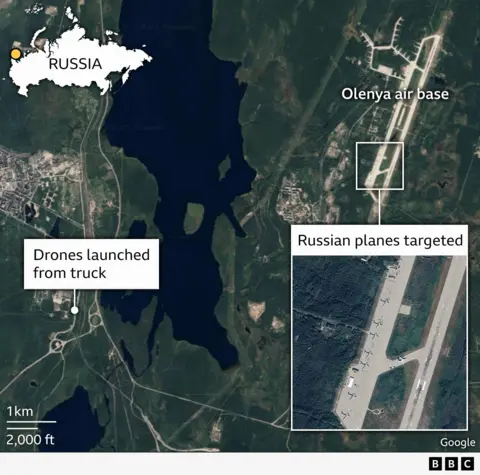
Russia has said it has detained people in connection with the attack, although Zelensky stated the people who had helped facilitate the operation “were withdrawn from Russian territory… they are now safe”.
In a now-deleted Telegram post, local authorities from the city of Ust-Kut in the Irkutsk region said they were looking for a Ukrainian-born 37-year-old in connection with the drone attack on the Belaya military airfield.
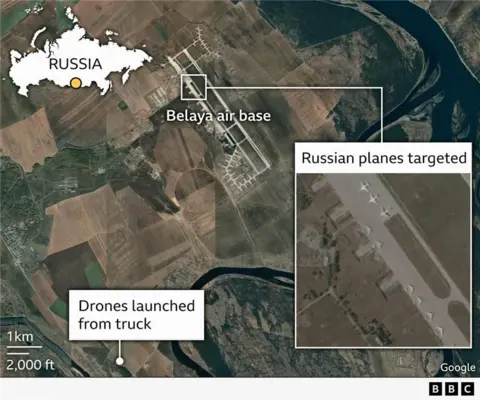
The drones
Images shared by the SBU show dozens of small black drones neatly stashed in wooden cabins inside a warehouse, which Russian military bloggers pinpointed to a location in Chelyabinsk.
Dr Steve Wright, a UK-based drone expert, told the BBC the drones used to hit Russian aircraft were simple quadcopters carrying relatively heavy payloads.
He added that what made this attack “quite extraordinary” was the ability to smuggle them into Russia and then launch and command them remotely – which he concluded had been achieved through a link relayed through a satellite or the internet. Zelensky said each of the 117 drones launched had its own pilot.
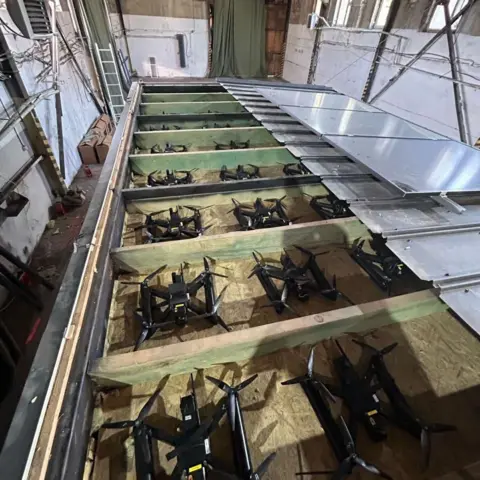 SBU
SBUDr Wright also suggested it was likely the drones were able to fly in using GPS but may have also overcome localised Russian jamming measures by manually piloting drones remotely.
Kyiv has not shared details on the origin of the drones, but since the start of the war Ukraine has become extremely efficient at manufacturing them – and it is possible the ones used in this operation were produced at home.
The targets
“Russia has had very tangible losses, and justifiably so,” said Zelensky in his nightly video address.
According to Ukraine, 41 strategic bombers were hit and “at least” 13 destroyed. Moscow has not confirmed any losses of aircraft beyond saying some planes had been damaged.
Videos verified by the BBC show damaged aircraft at the Olenegorsk air base in Murmansk and the Belaya air base in Irkutsk.
The strategic missile-carrying bombers targeted in the attack are thought to be – among others – the Tu-95, Tu-22 and Tu-160. Repairing them will be difficult and, because none are still in production, replacing them is impossible.
Radar satellite imagery shared by Capella Space reveals at least four badly damaged or destroyed Russian long-range bombers at Belaya airbase. This matches Ukrainian drone footage also showing an attack on a Tu-95 bomber.
“According to the laws and customs of war, we have worked out absolutely legitimate targets – military airfields and aircraft that bomb our peaceful cities,” said SBU head Vasyl Malyuk.
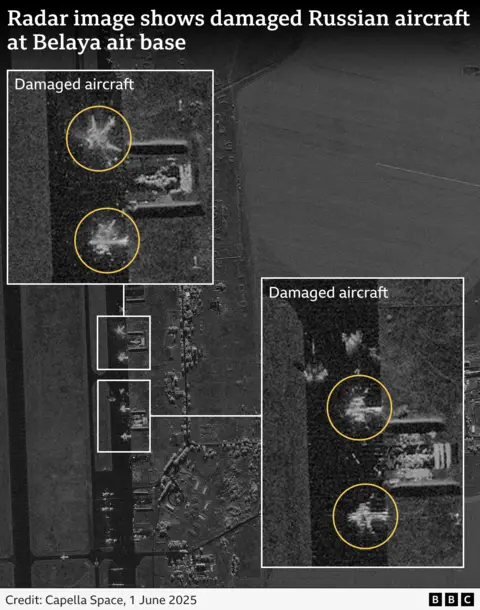
Tu-95 bombers are said to have launched a large-scale Kh-101 missile attack on Ukraine as recently as last week. Each bomber can carry eight guided cruise missiles and each missile itself carries a 400kg (882lb) warhead.
A-50 military spy planes were also reportedly targeted. They are valuable aircraft that boost Russia’s ability to both intercept Ukrainian missiles and to launch its own strikes.
It is not known how many A-50s Russia has – but in February 2024 military intelligence chief Kyrylo Budanov put that number at eight, so any loss or damage could be a serious blow to Moscow.
In a post on social media, the SBU said operation Spider Web cost Russia $7bn (£5.2bn).
Russian state media stayed studiously quiet on the attacks, with primetime Sunday TV shows merely quoting statements by regional authorities. By Monday morning, the story had disappeared from the bulletins.
On the internet and beyond Ukrainians celebrated, with one lauding the operation as “titanic”.
“Of course, not everything can be revealed at this moment,” Zelensky wrote on Telegram, “but these are Ukrainian actions that will undoubtedly be in history books.”
Additional reporting by Kumar Malhotra, Tom Spencer, Richard Irvine-Brown, Paul Brown and Benedict Garman
Source link
